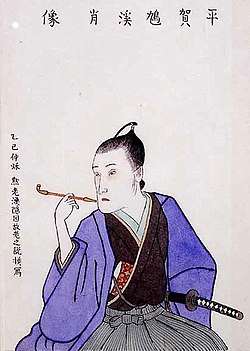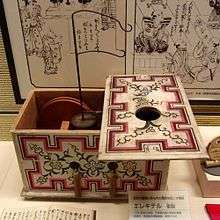Hiraga Gennai
Hiraga Gennai (平賀 源内, 1728 – 24 January 1780) was a Japanese polymath of the Edo period.
Hiraga Gennai | |
|---|---|
平賀 源内 | |
 1845 A Portrait of Kyūkei Hiraga (1728–80) by Momuō Kimura | |
| Born | 1728 Sanuki, Sanuki Province, Japan |
| Died | January 24, 1780 |
| Other names | Kyūkei (鳩渓), Fūrai Sanjin (風来山人), Tenjiku rōnin (天竺浪人) and Fukuchi Kigai (福内鬼外) |
| Education | student of Rangaku |
| Occupation | physician, author, painter and inventor |
.jpg)

Gennai was a pharmacologist, student of Rangaku, physician, author, painter and inventor well known for his Erekiteru (electrostatic generator), Kandankei (thermometer), and Kakanpu (asbestos cloth). Gennai composed several works on homosexual life and desire in Japan, such as the Nenashigusa (1763), the Kiku no en (1764), the San no asa (1768), and the Nenashigusa kohen (1768), and also wrote the satirical essay "On Farting".
Biography
Hiraga Gennai was born in 1728 in Sanuki, Sanuki Province, the third son of a low-ranking samurai family in service of the Takamatsu Domain. His father, Shiraishi Mozaemon (Yoshifusa), and his mother were both from the Yamashita clan. Gennai's real name was Kunitomo (国倫), but he also went by the pen names Kyūkei (鳩渓), Fūrai Sanjin (風来山人) (his principal literary pen name), Tenjiku rōnin (天竺浪人) and Fukuchi Kigai (福内鬼外), but is most well known by the name Gennai.
Gennai first studied medicinal herbs in Osaka with Toda Kyokuzan before moving to Edo in 1757, where he studied with Tamura Ransui, and wrote a number of books, some on scientific or nature topics, some satirical novels, in the kokkeibon and dangibon genres. In his scientific experiments, Gennai prospected for various ores, wove asbestos, calculated temperatures, and worked with static electricity. Gennai also studied Western painting and ceramics techniques, and produced a number of works in that vein.
Gennai was homosexual and, being fond of the loves of males to the complete exclusion of females, composed several works on the subject, including guidebooks on male prostitutes and works of fiction that concentrated on sex between men over heterosexuality.[1]
Interested in ores, Gennai tried unsuccessfully a number of times to have new mines opened due to lack of support from the citizens of the Edo area. Reportedly, on one occasion in 1779, Gennai was so frustrated at the repeated lack of support that he killed one of his disciples in a fit of rage. Gennai was subsequently arrested and sent to prison, where he died on 24 January 1780.
Gennai ware
_with_Design_of_Scholars_in_Garden_LACMA_M.2006.214.21.jpg)
Gennai made or instructed a number of Japanese pottery pieces which are named Gennai ware after him. The style is unique with brilliant colours, mostly three, following the Kōchi ware style from Gennai's native island of Shikoku.[2]
Appearances in fiction
- Gennai appears as a scholar/inventor and cross-dressing lesbian in manga Ōoku: The Inner Chambers (2005- ) by Fumi Yoshinaga.
- In the anime OVA: Mask of Zeguy Hiraga Gennai had a prominent role (along with Hijikata Toshizo) in protecting Miki (who is a descendant of the renowned Priestess Shamus) and preventing the legendary mask from falling into the wrong hands.
- In the anime OVA: T.P. Sakura, Hiraga Gennai appears in addition to his elekiter.
- In the anime Oh! Edo Rocket episode 10 it is revealed that the retired resident is Gennai. The Fūrai Row-House Block, which he says is his, is also likely a nod to one of his pen names.
- In the anime Gintama, there is a mechanic known as Hiraga Gengai.
- The anime Zero no Tsukaima has a character by the name of Hiraga Saito. Since Saito hails from Japan, it is speculated that he is named after Gennai.
- Gennai makes an appearance in the anime Read or Die, along with the clones of many other historical and legendary figures. In Read Or Die, Gennai uses his elekiter as a very high powered destructive weapon that he uses to destroy the White House and eradicate an entire fleet of combat helicopters.
- A giant mechanical frog is named after him in Mai-HiME.
- In the anime Flint the Time Detective, he makes an appearance with the Time Shifter Elecky as he uses it to make giant robots.
- In the Square game Live-A-Live, there is a mechanic named Gennai who is responsible for the creation of mechanical traps in the Bakumatsu Chapter. Since the setting of the chapter is the Bakumatsu era, his presence is an anachronism, but considering the additional presence of Ishikawa Goemon, Yodo-Dono, and Shiro Tokisada Amakusa, it is clear that this section of the game was intentionally designed as a mash-up of popular Japanese history.
- In the 36th episode of Kikaida 01 Hiraga Gennai is threatened by time traveling robots from 1974 disguised as ninja. The evil Shadow tends to take him to 1974 and have him help build better robots.
- In the 30th episode of Demashita! Powerpuff Girls Z (ガールズとカレ!, "Girls and Him!"), a character by the name of Hiraga Kennai is responsible for the creation of a primitive form of Chemical Z and the Ōedo Chakichaki Musume. He also uses an elekiter to separate Him's soul (the black light) from his body.
- In the 13th episode of the first season of the anime Digimon Adventure (エンジェモン覚醒!, "Angemon's Awakening!"), an elderly man named Gennai appears to the Chosen Children/Digidestined and helps them with their journey. He reappears in the second season called Digimon Adventure 02 as a younger man. His Digimon Adventure design appears to be based on old-fashioned Japanese styles, and both it and his name were likely inspired by the historical Gennai.
- In the light novel Hidan no Aria, Gennai is the famous ancestor of the Amdo Butei Aya Hiraga.
- In the 6th episode of the anime Sengoku Collection he is embodied in a genius and clumsy girl.
- In the anime Carried by the Wind: Tsukikage Ran, Gennai makes an appearance in episode 7.
- Takashi Yamaguchi played Hiraga Gennai in Tenkagomen, an NHK drama series (1971–72)
- In a mobile card turn-based video game Valkyrie Crusade, a female version of Hiraga exists as a card. Elekiter also mentioned with "her".
- In the Free-to-play MMORPG Onigiri (video game), there is a female version of Hiraga Gennai. She is part of the main quest line story. As a special partner character, players can also control her using the 'Vanguard Swap' feature.
References
- Leupp, Gary (1997). Male Colors: The Construction of Homosexuality in Tokugawa Japan. University of California Press. p. 75, 86, 102.
- "福岡市美術館". Fukuoka-art-museum.jp. Retrieved 2020-04-28.
Further reading
- Bogdan, David R.; Yasunori Fukuda (2018-06-29). "Hiraga Gennai, Rangaku, and Foreign Language -Approaches to Foreign Language Learning during Japan's Isolation Period" (PDF). Bulletin of the Faculty of Education. Ehime University. 65: 85–96.
External links
![]()